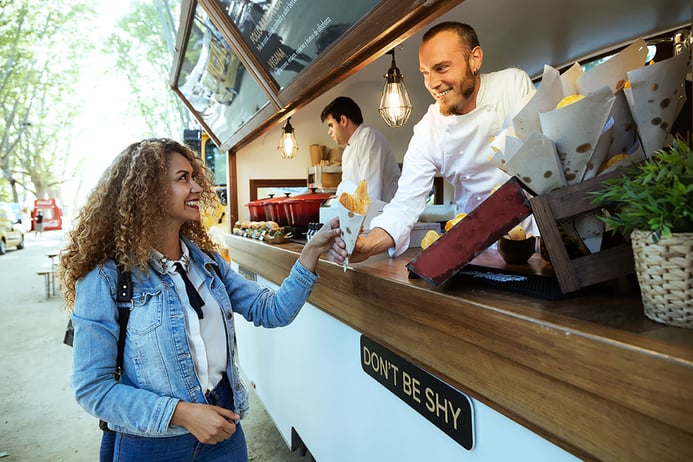Pop-up restaurants have exploded in popularity in recent years, particularly since the pandemic reshaped the dining landscape. As traditional restaurants struggled with closures and restrictions, pop-ups emerged as agile, creative solutions that allowed chefs and entrepreneurs to continue serving food and connecting with customers in new ways. They offer something fresh, temporary, and exciting—whether it’s a single-night tasting menu in an art gallery or a three-month kitchen residency in a brewery.
According to industry reports, pop-up restaurants are not only trending but also becoming a preferred business model for many new restaurateurs. The global market for pop-up dining experiences is expected to grow steadily, especially in urban centers and foodie hubs. The appeal is clear: lower overheads, faster launches, and the opportunity to test concepts without committing to a long-term lease.
For aspiring food and beverage (F&B) entrepreneurs, pop-up kitchens offer a way to bring a dream to life with less risk and more creative freedom. This guide covers everything you need to know—from what pop-ups are and how they work to a step-by-step guide for starting your own.
What Is a Pop-Up Restaurant?
A pop-up restaurant is a temporary dining concept that operates for a limited time and often in unconventional locations. These can range from converted shipping containers and rooftops to art galleries, co-working spaces, or private homes.
Unlike food trucks, which have a small footprint and limited seating, or traditional restaurants that follow standard food and beverage models, pop-up restaurants create a memorable, often exclusive dining experience that feels more like an event than a typical restaurant meal.
Pop-ups can last anywhere from one night to several months. They may feature a fixed menu, a theme, or a unique collaboration between chefs. Many pop-ups are designed to test new ideas, build a brand following, or create buzz around a future permanent restaurant.
The term “pop-up kitchen” is also used to describe these operations, particularly when they are set up in shared commercial food outlets, food halls, or ghost kitchen facilities. These spaces provide entrepreneurs with the necessary equipment and infrastructure to operate a restaurant without the need for a full-scale establishment.
Pros and Cons of Pop-Up Kitchens vs. Traditional Restaurants
Pop-up kitchens are ideal for passionate entrepreneurs ready to hustle and get creative. They offer more freedom than traditional restaurants but also come with their own unique pressures.
Pros
- Lower Startup Costs: No need for a permanent lease or full build-out.
- Flexibility: Test menus, concepts, and locations with minimal risk.
- Faster to Launch: Many pop-ups can be organized in a matter of weeks.
- Brand Building: Generate buzz and build a following through social media and events.
- Creative Freedom: Try out bold ideas that might not fit in a traditional setting.
Cons
- Unpredictable Revenue: Without consistency, income can fluctuate.
- Logistical Challenges: Limited space, storage, and equipment can complicate operations. Necessities such as parking and restrooms are also a factor.
- Permit Complexity: Temporary food licenses and venue agreements can be difficult or expensive to obtain, depending on the location.
- Heavy on Marketing: Success depends on visibility and promotion.
- Limited Scalability: Hard to grow without strategic planning.
Examples of Successful Pop-Up Restaurants
Many successful food brands started as pop-ups. Here are a few inspirational stories:
- Noma’s Global Pop-Ups: Copenhagen’s legendary Noma launched pop-ups in Mexico, Japan, and Australia, turning them into international culinary events

Image Credit: Noma.dk - Roy Choi’s Kogi BBQ: What began as a food truck serving Korean-Mexican fusion in LA grew into a pop-up phenomenon and then into a multi-location restaurant brand.

Image Credit: Tacosporvida.la - Dishoom at the Southbank Centre: Before expanding across the UK, Dishoom tested its concept through popular pop-up residencies that built a loyal following.

Image Credit: Babesabouttown.com
Other indie chefs have used pop-up kitchens to connect with niche audiences, explore experimental cuisines, or partner with local brands.
Social media often plays a crucial role, with Instagram and TikTok helping to amplify reach and drive foot traffic.
How Much Does It Cost to Start a Pop-Up Restaurant?
Startup costs can vary widely based on your location, duration, and concept. However, here’s a rough breakdown of what to expect:
Total Estimated Cost: $3,000 to $15,000 for a short-term pop-up.
Costs can be lower if you partner with an existing venue (like a bar or shared kitchen), or higher if you’re planning a large-scale, multi-week event. Planning carefully and budgeting conservatively is key.
Licensing Laws and Food Regulations
Pop-up restaurants must comply with local food safety laws and business regulations, which can vary significantly. Generally, you’ll need:
1. Food Handler Certifications
Most regions require food prep staff to complete certified food safety training.
2. Health Department Permits
You’ll likely need a Temporary Food Establishment Permit. This involves an inspection of your setup and sometimes a detailed menu review.
3. Business License and Insurance
It’s important to register your business entity and secure general liability insurance to cover potential accidents or issues.
4. Alcohol Permits
If you plan to serve alcohol, you’ll need the appropriate temporary or event-specific license. This can be simplified by collaborating with venues that already have liquor licenses.
5. Zoning and Use Permissions
Make sure your chosen venue complies with zoning laws and has the appropriate use classification for food service.
Working with commissary kitchens or event venues experienced in pop-ups can simplify the regulatory process. Always contact your local health department early in your planning.
How to Open a Pop-Up Kitchen: Step-by-Step Guide
A pop-up kitchen is more than a temporary eatery—it’s an experience, a spark of creativity, and a powerful way to test your vision in the real world. With the right planning, it can become a launchpad for your brand, turning a temporary idea into lasting impact.
Step 1: Define Your Concept
Think about what makes your food or dining experience stand out. Is it your cultural heritage, a unique fusion, or an artistic presentation? Determine your target audience and tailor your offering accordingly.
Step 2: Create a Business Plan
Even for a pop-up, a business plan is an essential tool that helps you clarify:
- Budget and startup costs
- Menu pricing and sourcing
- Timeline and logistics
- Marketing strategy
Don’t forget to include your goals (testing a concept, gaining investors, building a following) and define what success looks like.
Step 3: Choose a Location
While one might imagine that a pop-up restaurant could be done anywhere, the need for sufficient facilities to ensure the health, safety, and comfort of diners and workers is key.
Here are some of the safest options where you know you’ll have access to good facilities in a place that is accustomed to welcoming guests:
- Event spaces
- Breweries or bars (for food pop-ups)
- Commercial or ghost kitchens
- Shared restaurant spaces (during off hours)
- Festivals
For more off-beat settings, you can also investigate places such as:
- Rooftops
- Boats
- Parks and gardens
- Arcades
- Art galleries and museums
- Bowling alleys
- Warehouses
However, these types of locations carry more risk and require careful planning and research into the requirements for permits and permissions.
When visiting potential locations, allow yourself enough time to take a thorough tour. Take the time to record a video and/or take pictures to capture elements you may overlook the first time around.
Additionally, carefully assess the key points related to safety and logistics, such as kitchen access, parking, foot traffic, washrooms, protection from inclement weather, and the surrounding environment.
Step 4: Handle Legal & Licensing Requirements
Very early in the process, it’s best to contact your local health department and licensing office to:
- Apply for permits
- Schedule inspections
- Learn the required documentation
Don’t forget to inquire about the cost of these steps to include in your budget. It’s also important at this stage to get liability insurance and carefully study any contracts or agreements with landlords or hosts.
Step 5: Rent or Equip Your Pop-Up Kitchen
To get your hands on the right equipment and space to prepare your culinary masterpieces, without long-term commitments, consider these flexible arrangements:
- Renting a commissary kitchen: a licensed commercial-grade kitchen space that can be rented for the preparation and storage of food.
- Leasing a mobile kitchen trailer: They come in a variety of shapes and sizes, look like a cross between a mobile home and food truck, and can be hitched to an appropriately equipped and powered vehicle.
- Partnering with restaurants or bars: Sometimes available for rent during off-hours, fully equipped F&B establishments offer the benefits of having furniture and washrooms.
Before signing up for one of these options, ensure your space is equipped with proper refrigeration, hand-washing stations, and adequate storage. You will also want to plan for the logistics of deliveries and cleaning after use.
Step 6: Develop Your Menu & Sourcing
Pop-ups aren’t expected to offer a huge range of dishes, so you can keep the menu tight and focused. Consider food that:
- Travels well (if to-go or delivery)
- Has low prep time
- Uses seasonal/local ingredients. Setting up a stand of locally-sourced food products or beverages can also enhance the offer.
- Can be easily adapted for food allergies/preferences (vegan, no gluten, etc.)
Lastly, don’t forget to secure reliable suppliers and plan to prepare as much as possible ahead of time.
Step 7: Set Up Marketing & Promotion
It’s essential to strike the sweet spot for timing, aiming for neither too early, when people will forget about it, nor too late, when everyone already has plans. In addition to using your personal network and word-of-mouth tactics, you can promote your pop-up kitchen through:
- Instagram, TikTok, and Facebook
- Email lists and food blogs
- Event platforms (Eventbrite, Meetup)
Now, revisit your business plan and create a brand look, hashtag, and launch story that brings your brand to life. You can also collaborate with influencers or local media for added buzz.
Step 8: Run a Soft Launch
To give your pop-up kitchen a test run and work out any kinks, consider inviting friends, family, and local food enthusiasts to a preview night. Take this opportunity to test your menu and workflow, gather valuable feedback, and make adjustments before launching it to the public.
Step 9: Blast-Off!
On launch day, here are a few things you can do to increase the buzz:
- Offer specials or limited-time offers
- Document everything on social media (consider outsourcing this to a friend or pro, because you’ll have your hands full in the kitchen)
- Encourage customer reviews and photos
- Invite local VIPs such as radio and television personalities, city representatives, or food critics.
Most importantly, stay calm and focus on providing great food and memorable service.
Step 10: Evaluate and Iterate
After your pop-up ends, it’s time to review:
- Profitability
- Customer feedback
- Operational challenges
With data in hand, you can decide whether to repeat, pivot, or pursue a permanent space. Pop-ups can lead to restaurant openings, catering gigs, or branded product lines.
From Pop-Up to Powerhouse
Pop-up restaurants are a powerful entry point for new food entrepreneurs. They offer flexibility, excitement, and a chance to bring fresh culinary ideas to life without the weight of a permanent lease. Whether you’re launching a vegan taco bar in a brewery or a gourmet ramen cart at a festival, the pop-up kitchen model gives you the tools to test, learn, and grow.
Key takeaways: Start small, plan carefully, and don’t be afraid to stand out. Your pop-up could be the first chapter in a long and flavorful journey.





